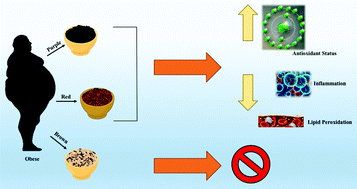The anti-inflammatory and antioxidant effects of pigmented rice consumption in an obese cohort†
Abstract
The development of lifestyle diseases in the obese has been attributed to higher levels of inflammation and free radical mediated oxidative stress. The antioxidant and anti-inflammatory properties of polyphenols in pigmented rice varieties could have potential to neutralize oxidative stress and modulate inflammatory responses in the obese. A cross-over dietary intervention human clinical trial was conducted with three pigmented rice varieties chosen from previous chemical and in vitro antioxidant and anti-inflammatory screening. Obese (n = 22, BMI > 30) sedentary participants consumed one cup of pigmented rice (Reiziq (brown), Purple (purple) and Yunlu29 (red)). Blood samples were collected prior consumption (baseline) and at set time points of 30 minutes, 1 hour, 2 hours and 4 hours post rice consumption. The collected blood samples were analysed for antioxidant and inflammatory biomarkers. Total antioxidant activity increased (p < 0.001) at the 1 hour time point by 40.3% post purple rice consumption. The red rice variety, Yunlu29 increased antioxidant activity at the 30 minute (p < 0.001) and 1 hour (p < 0.01) time point by 29.5% and 21.2% respectively. Lipid peroxidation biomarker, malondialdehyde (MDA), decreased (p < 0.05) at the 30 minute time point by 6.8% post purple rice consumption. At the 4 hour time point MDA levels was significantly reduced (p < 0.001) by the red rice variety Yunlu29, by 9.6%. Pro-inflammatory cytokine, interleukin-10 (IL-10), was significantly (p < 0.0001) reduced by 3.1% 30 minutes post purple rice consumption. In contrast, Yunlu29 (red) reduced interleukin-6 levels by 13.6% and 11.0% at the 30 minute and 1 hour time points respectively. Both the purple (p < 0.01) and red (p < 0.001) varieties significantly reduced interleukin-12p70 concentrations at 30 minutes by 8.7% and 10.3% respectively. Reiziq (brown) did not affect any of the biomarkers analysed in this study. The outcomes of this study highlight that polyphenols found in pigmented rice may play a key role in targeting specific therapeutic pathways in obesity-related oxidative stress and inflammation.



 Please wait while we load your content...
Please wait while we load your content...